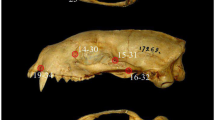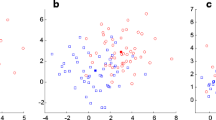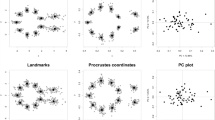Abstract
One of the most basic but problematic issues in modern morphometrics is how many specimens one needs to achieve accuracy in samples. Indeed, this is one of the most regularly posed questions in introductory courses. There is no simple and certainly no absolute answer to this question. However, there are a number of techniques for exploring the effect of sampling, and our aim is to provide an example of how this might function in a simplified but informative way. Thus, using resampling methods and sensitivity analyses based on randomized subsamples, we assessed sampling error in horse teeth from several modern and fossil populations. Centroid size and shape of an upper premolar (PM2) were captured using Procrustes geometric morphometrics. Means and variances (using three different statistics for shape variance) were estimated, as well as their confidence intervals. Also, the largest population sample was randomly split into progressively smaller subsamples to assess how reducing sample size affects statistical parameters. Results indicate that mean centroid size is highly accurate; even when sample size is small, errors are generally considerably smaller than differences among populations. In contrast, mean shape estimation requires large samples of tens of specimens (ca. >20), although this requirement may be less stringent when variance in a population is very small (e.g. populations that underwent strong genetic bottlenecks). Variance in either centroid size or shape can be highly inaccurate in small samples, to the point that sampling error makes it as variable as differences among spatially and chronologically well-separated populations, including two which are highly distinctive as a consequence of strong artificial selection. Likely, centroid size and shape variance require no <15–20 specimens to achieve a reasonable degree of accuracy. Results from the simplified sensitivity analysis were largely congruent with the pattern suggested by bootstrapped confidence intervals, as well as with the observations of a previous study on African monkeys. The analyses we performed, especially the sensitivity assessment, are simple and do not require much time or computational effort; however, they do necessitate that at least one sample is large (50 or more specimens). If this type of analyses became more common in geometric morphometrics, it could provide an effective tool for the preliminarily exploration of the effect of sampling on results and therefore assist in assessing their robustness. Finally, as the use of sensitivity studies increases, the present case could form part of a set of examples that allow us to better understand and estimate what a desirable sample size might be, depending on the scientific question, type of data and taxonomic level under investigation.








Similar content being viewed by others
References
Adams DC, Rohlf FJ, Slice DE (2004) Geometric morphometrics: ten years of progress following the “revolution”. It J Zool 71:5–16
Adams D, Rohlf F, Slice D (2013) A field comes of age: geometric morphometrics in the 21st century. Hystrix It J Mammal 24:7–14
Amori G, Aloise G, Luiselli L (2014) Modern analyses on an historical data set: skull morphology of Italian red squirrel populations. ZooKeys 368:79–89
Betti L (2014) Sexual dimorphism in the size and shape of the os coxae and the effects of microevolutionary processes. Am J Phys Anthropol 153:167–177
Bogdanović AM, Ivanović A, Tomanović Ž et al (2009) Sexual dimorphism in Ephedrus persicae (Hymenoptera: Braconidae: Aphidiinae): intraspecific variation in size and shape. Canad Entomol 141:550–560
Cardini A (2003) The geometry of the marmot (Rodentia: Sciuridae) mandible: phylogeny and patterns of morphological evolution. Syst Biol 52:186–205
Cardini A (2013) Geometric morphometrics. In: EOLSS encyclopedia of life support systems
Cardini A (2014) Missing the third dimension in geometric morphometrics: how to assess if 2D images really are a good proxy for 3D structures? Hystrix. doi:10.4404/hystrix-25.2-10993
Cardini A, Elton S (2007) Sample size and sampling error in geometric morphometric studies of size and shape. Zoomorphol 126:121–134
Cardini A, O’higgins P (2004) Patterns of morphological evolution in Marmota (Rodentia, Sciuridae): geometric morphometrics of the cranium in the context of marmot phylogeny, ecology and conservation. Biol J Linn Soc 82:385–407
Cardini A, Thorington RW Jr, Polly PD (2007) Evolutionary acceleration in the most endangered mammal of Canada: speciation and divergence in the Vancouver Island marmot (Rodentia, Sciuridae). J Evol Biol 20:1833–1846
Caumul R, Polly PD (2005) Phylogenetic and environmental components of morphological variation: skull, mandible, and molar shape in marmots (Marmota, Rodentia). Evolution 59:2460–2472
Chiozzi G, Bardelli G, Ricci M et al (2014) Just another island dwarf? Phenotypic distinctiveness in the poorly known Soemmerring’s Gazelle, Nanger soemmerringii (Cetartiodactyla: Bovidae), of Dahlak Kebir Island. Biol J Linn Soc 111:603–620
DiCiccio TJ, Efron B (1996) Bootstrap confidence intervals. Stat Sci 11:189–212
Drake AG, Klingenberg CP (2010) Large scale diversification of skull shape in domestic dogs: disparity and modularity. Am Nat 175:289–301
Dryden I (2009) Shapes: statistical shape analysis. R package version 1
Evans A (2013) Shape descriptors as ecometrics in dental ecology. Hystrix It J Mammal 24:133–140
Fox J, Weisberg HS (2010) An R companion to applied regression. Sage, Thousand Oaks
Gómez-Robles A, Martinón-Torres M, Bermúdez de Castro JM et al (2011) A geometric morphometric analysis of hominin upper premolars. Shape variation and morphological integration. J Hum Evol 61:688–702
Hammer O, Harper D, Ryan P (2001) PAST: paleontological statistics software package for education and data analysis. Paleontol Electron 4(1):1–9
Harmon LJ, Losos JB (2005) The Effect of intraspecific sample size on type I and type II error rates in comparative studies. Evolution 59:2705–2710
Howell DC (2009) Statistical methods for psychology. Cengage Learn, Wadsworth, p 793
Ivanović A, Sotiropoulos K, Džukić G, Kalezić ML (2009) Skull size and shape variation versus molecular phylogeny: a case study of alpine newts (Mesotriton alpestris, Salamandridae) from the Balkan Peninsula. Zoomorphology 128:157–167
Klingenberg CP (2011) MorphoJ: an integrated software package for geometric morphometrics. Mol Ecol Res 11:353–357
Klingenberg CP (2013a) Cranial integration and modularity: insights into evolution and development from morphometric data. Hystrix It J Mammal 24:43–58
Klingenberg CP (2013b) Visualizations in geometric morphometrics: how to read and how to make graphs showing shape changes. Hystrix It J Mammal 24:15–24
Kocovsky PM, Adams JV, Bronte CR (2009) The effect of sample size on the stability of principal components analysis of truss-based fish morphometrics. Trans Am Fish Soc 138:487–496
Kryštufek B, Klenovšek T, Bužan EV et al (2012) Cranial divergence among evolutionary lineages of Martino’s vole, Dinaromys bogdanovi, a rare Balkan paleoendemic rodent. J Mammal 93:818–825
Manly BFJ (1997) Randomization, bootstrap and Monte Carlo methods in biology. Chapman and Hall, London
Meloro C (2011) Feeding habits of Plio-Pleistocene large carnivores as revealed by the mandibular geometry. J Vertebr Paleontol 31:428–446
Mitrovski-Bogdanović A, Petrović A, Mitrović M et al (2013) Identification of two cryptic species within the Praon abjectum group (Hymenoptera: Braconidae: Aphidiinae) using molecular markers and geometric morphometrics. Ann Entomol Soc Am 106:170–180. doi:10.1603/AN12100
Monteiro LR (2013) Morphometrics and the comparative method: studying the evolution of biological shape. Hystrix It J Mammal 24:25–32
Oksanen J, Guillaume Blanchet F, Kindt R et al (2011) Vegan: community ecology package. R package ver. 2.0-2
Polly PD (2005) Development and phenotypic correlations: the evolution of tooth shape in Sorex araneus. Evol Dev 7:29–41
Ponssa ML, Candioti MFV (2012) Patterns of skull development in anurans: size and shape relationship during postmetamorphic cranial ontogeny in five species of the Leptodactylus fuscus Group (Anura: Leptodactylidae). Zoomorphol 131:349–362
R Core Team (2014) R: a language and environment for statistical computing. R Foundation for Statistical Computing, Vienna
Raia P, Carotenuto F, Meloro C et al (2010) The shape of contention: adaptation, history, and contingency in ungulate mandibles. Evolution 64:1489–1503
Renaud S, Auffray JC (2010) Adaptation and plasticity in insular evolution of the house mouse mandible. J Zool Syst Evol Res 48:138–150
Renaud S, Auffray J-C (2013) The direction of main phenotypic variance as a channel to evolution: cases in murine rodents. Hystrix It J Mammal 24:85–93
Renaud S, Pantalacci S, Auffray J-C (2011) Differential evolvability along lines of least resistance of upper and lower molars in island house mice. PLoS One 6:e18951
Renner MAM, Brown EA, Wardle GM (2013) Averaging v. outlier removal. Decrypting variance among cryptic Lejeunea species (Lejeuneaceae: Jungermanniopsida) using geometric morphometrics. Aust Syst Bot 26:13–30
Rohlf F (2013a) Tps series. State University of New York, Stony Brook. http://life.bio.sunysb.edu/morph/index.html
Rohlf FJ (2013b) NTSYSpc: numerical taxonomy system, ver. 2.1. Exeter, Setauket
Rohlf FJ, Slice D (1990) Extensions of the procrustes method for the optimal superimposition of landmarks. Syst Zool 39:40–59
Seetah TK, Cardini A, Miracle PT (2012) Can morphospace shed light on cave bear spatial–temporal variation? Population dynamics of Ursus spelaeus from Romualdova pećina and Vindija, (Croatia). J Archaeol Sci 39:500–510. doi:10.1016/j.jas.2011.10.005
Seetah K, Cucchi T, Dobney K, Barker G (2014a) A geometric morphometric re-evaluation of the use of dental form to explore differences in horse (Equus caballus) populations and its potential zooarchaeological application. J Archaeol Sci 41:904–910
Seetah K, Cardini A, Barker G (2014b) The long fuse domestication of the horse (in preparation)
Sheets H, Zelditch M (2013) Studying ontogenetic trajectories using resampling methods and landmark data. Hystrix It J Mammal 24:67–73
Tversky A, Kahneman D (1971) Belief in the law of small numbers. Psychol Bull 76:105
Viscosi V, Cardini A (2011) Leaf morphology, taxonomy and geometric morphometrics: a simplified protocol for beginners. PLoS One 6:e25630
Wainer H (2007) The most dangerous equation. Am Sci 95:249
Walmsley A, Elton S, Louys J et al (2012) Humeral epiphyseal shape in the felidae: the influence of phylogeny, allometry, and locomotion. J Morphol 273:1424–1438
Zelditch M, Swiderski D, Sheets D, Fink W (2004) Geometric morphometrics for biologists: a primer. Elsevier Academic Press, Waltham
Acknowledgments
Funding was provided to G.B. from the Leverhulme Trust project grant scheme (F/09 757/B) and to K.S. and A.C. from the Lang Fund for Human-Environmental Anthropology, Department of Anthropology, Stanford. We are extremely grateful to the following for facilitating access to materials and providing essential input for specific samples: ICE and PRZ: F. Mayer (Museum für Naturkunde, Berlin); THB and PRZ: R. Sabin and L. Tomsett (Natural History Museum, London); CHI: T. Yaqi and H. Songmei (Shaanxi Archaeological Research Institute, Xi’an), KAZ: Z. Samashev and K. Kashkanbajev (Institute of Oriental Studies, Almaty), RUS: P. Kotsinsev (Institute of Ecology of Plants and Animals, Yekaterinburg) and B. Hanks (Department of Archaeology, Pittsburgh); CRO: D. Brajkovic (Institute for Quaternary Palaeontology and Geology, Zagreb) and P. Miracle (Department of Archaeology, Cambridge) and HUN: A. Choyke (Department of Medieval Studies, Budapest) and A. Endrődi (Budapest History Museum, Budapest). We thank N. Vibla and J. Li for assistance in recovering samples and translation; A. Evin (Natural History Museum, Paris) for providing a set of duplicate samples from Berlin. We are deeply grateful to: I. Dryden (University of Nottingham), P. Gunz (Max Planck Institute for Evolutionary Anthropology, Leipzig), L. Monteiro (Universidade Estadual do Norte Fluminense), S. Schlager (University of Freiburg) and other MORPHMET subscribers for help and suggestions with R scripts and packages, as well as with references; P. Mitteroecker (University of Vienna) for his important feedback on how to estimate multivariate variance; and P.D. Polly (Indiana University, Bloomington) for the most useful discussions on teeth evolution and shape analysis. Also, we would like to thank a lot two anonymous reviewers who provided truly interesting and most constructive comments that greatly improved the original version of this manuscript.
Author information
Authors and Affiliations
Corresponding author
Additional information
Communicated by Andreas Schmidt-Rhaesa.
Electronic supplementary material
Below is the link to the electronic supplementary material.
Rights and permissions
About this article
Cite this article
Cardini, A., Seetah, K. & Barker, G. How many specimens do I need? Sampling error in geometric morphometrics: testing the sensitivity of means and variances in simple randomized selection experiments. Zoomorphology 134, 149–163 (2015). https://doi.org/10.1007/s00435-015-0253-z
Received:
Revised:
Accepted:
Published:
Issue Date:
DOI: https://doi.org/10.1007/s00435-015-0253-z




